Interview with the Digiscoper of the Year 2011: Tara Tanaka
The results for the Swarovski Digiscoper of the Year 2011 competition have just been announced:
https://digiscoperoftheyear.com/
This year’s winner is Tara Tanaka of Florida, USA. Although Tara has had some great entries in Digiscoper of the Year in the past, her entries this year really stood out; turning the heads of both the judges and the voting public. Tara’s image of a bathing Roseate Spoonbill (Platalea ajaja) shows vibrance and colour; dynamism and action – all things that make you wish you were there. A moment wonderfully captured: absolutely stunning. This last week, I peppered Tara with questions about her digiscoping, how she does it and what inspires her:
What drew you to digiscoping, and how did you get started?
In 1993 my husband and I bought a home on the edge of a 45-acre cypress swamp. Most years the swamp serves as a nesting site for Wood Ducks, Great Egrets, Great Blue Herons, Anhingas and endangered Wood Storks. In 2007 we reported over 150 Rusty Blackbirds in the Great Backyard Bird Count. Apalachee Audubon was responsible for verifying unusual sightings, and a representative called to ask if a couple of folks could come over and see our “150 Rusty Blackbirds.” One of them brought digiscoping gear. I was amazed that such a simple concept could work so well. In 2008 I put our old camcorder on a stool in front of our 30 year old spotting scope and videoed the emergence of eight newly hatched Hooded Mergansers from a nest box. Soon after that I retired from a career in Information Technology, and had more time at home to observe the abundance of wildlife in the swamp. By February of 2009 I could no longer stand to see so much beauty go unrecorded and unshared, so I decided to give digiscoping a try. I purchased a Nikon Prostaff scope and Coolpix P5100. In order to see the LCD screen I got a head-mounted jeweller’s loupe, but it did nothing to keep the sun off. I worked really hard figuring things out by trial and error, shooting lots and lots of photos.
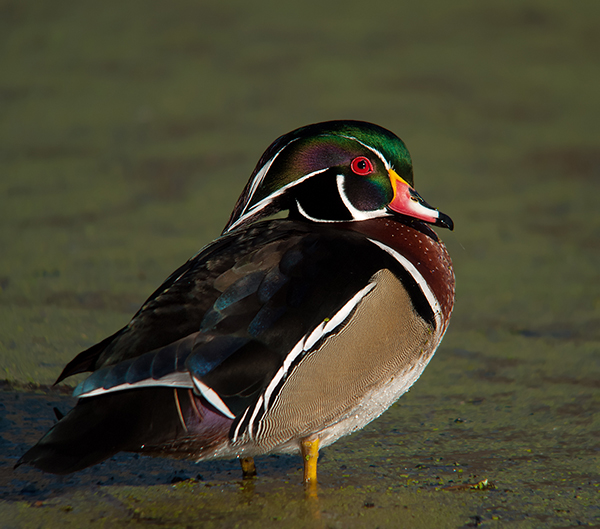
Tara: the ability to document unusual traits is also a great benefit of digiscoping. I knew about “eye flecks” in Oystercatchers, but have not been able to find any reported cases of their occurrence in Wood Ducks
I’ve never owned a DSLR and didn’t know Photoshop, and had no one to answer my growing list of questions. That April I attended a “Digiscoping with the Experts” session at the St. Augustine Birding and Photofest. By then I had dozens of burning questions and tried to ask most of them in that hour. It was there that I learned about the Yahoo “digiscopingbirds” group and I finally became a member of the digiscoping e-community. I soon realized that I was going to need to upgrade my equipment in order to attain the quality of images I was admiring on Flickr, and bought a Lumix G1. The electronic viewfinder of the G1 combined with continuous RAW shooting, 5x and 10x targeted magnification for fine focusing and electronic shutter release made this camera exactly what I was looking for. I also got a quality scope and could tell that this system had the potential to capture the quality of images I was striving for.
What approach do you typically use in capturing images?
Before I had the G1 it was virtually impossible for me to see the screen well enough—even after finally getting a Hoodman Loupe—to use any method besides autofocus. I really like photographing moving birds such as Reddish Egrets in a full-out run, and had a hard time using autofocus on quickly moving subjects. I found that with the greatly improved visibility of the G1’s LiveView that I could focus most of the time just by looking through the ViewFinder, using the targeted magnification when time permitted. After testing manual vs. autofocus on perched birds, I concluded that autofocus yielded no better results than manual focus, in many situations was too slow to use, and impossible in other circumstances such as when a bird is moving behind branches. Using manual focus exclusively allows me to get a lot of shots I would have missed trying to use autofocus.
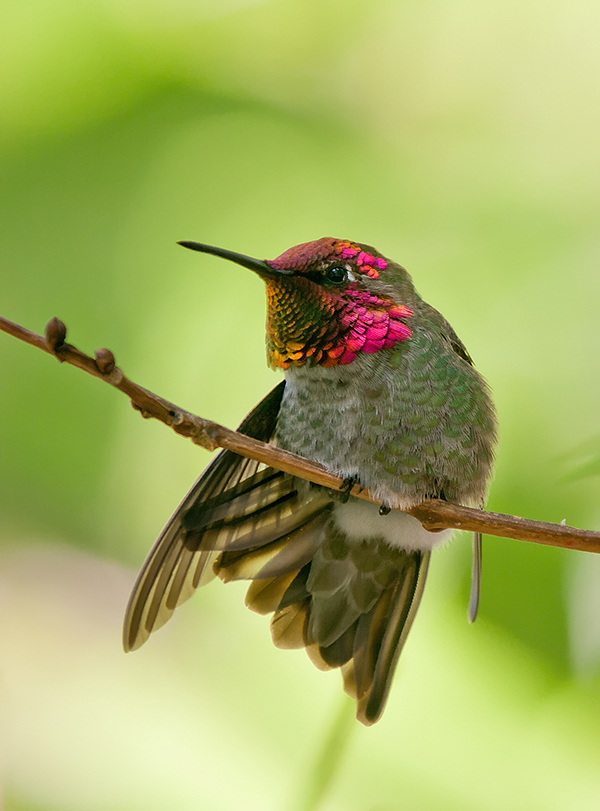
Tara Tanaka's stunning Anna's Hummingbird - one of my absolute favorite photos from this year's competition
Because of the relatively noisy sensor of the little G1, I almost never use an ISO higher than 400. When shooting in the shade, those relatively low ISOs usually result in shutter speeds below what is generally considered usable for digiscoping. I’ve learned that if you have a stable platform that’s out of the wind, an electronic shutter release, and you’re willing to have a low “keeper” percentage, you can photograph most species slower than 1/200 sec or even 1/100 sec. Most birds are not in constant motion. With rare exception they move and freeze, move and freeze. By shooting in continuous mode you’ll get some when they move and some when they freeze. This Anna’s Hummingbird photo was taken at 1/80 sec in the shade, and he was even stretching his wing when it was taken, but my digiscoping system was rock solid.
Where do you usually go to take photos?
Since I retired in 2008 my husband and I have spent almost a year in our travel trailer, mostly in the western U.S. We’ve visited all of the wonderful natural areas we could find, with an emphasis on birding destinations beginning in ’09 when I started digiscoping.
Even with all that time spent traveling, most of my digiscoping hours have been spent in our backyard. In addition to the birding afforded by the cypress swamp, my husband has managed our yard for wildlife—allowing wide buffers to grow and burning the area between the lawn and swamp annually. Last fall we had our first covey of Northern Bobwhite quail as a result of the restored, natural habitat,
and two years ago we had a family of Red Fox living in our yard.
Each year the Rusty Blackbirds return, but as elsewhere, their numbers are in steep decline. Last winter we had one contemplating the effects of prescribed fire:
Could you describe your artistic voice?
I love that digiscoping allows you to combine technical skill, artistic ability and a bit of a naturalist’s “eye” to capture nature’s beauty. The highest compliment I’ve ever received was from a woman who said “You really capture the birds’ personalities in your photos.” The male Great Egret “handing” the branch to the female is one of my favorite behavior/personality photos.
He had been displaying on that branch for three days, and she had just joined him that afternoon. Immediately after mating, his nest-building instinct kicked into high gear and he brought her the first branch for their nest. You can tell they’re a new couple and see her hesitancy to take the branch in her posture. I love the way the late afternoon light is illuminating them against the dark swamp, and the graceful curve of her neck. This photo was taken from well over 300’.
If I take ten photos of a bird that’s perched, but barely moving, one will usually stand out from the rest, and it can be the slightest tilt of the head, or the smallest difference in where the light hits the bird’s face. Since I upgraded to a GH1 I’ve really enjoyed video-scoping for the ability to capture interesting bird behavior.
I appreciate the capability that digiscoping affords in capturing details that usually aren’t visible to most birders. My husband was looking at a Cardinal portrait I had just taken and said he’d never seen the ring around the eye before. It was gratifying to be able to show my birding mentor a detail he hadn’t been aware of.
Your dream digiscoping day would be …
The day I took the winning Roseate Spoonbill photo WAS my dream digiscoping day. We were near the end of a ten-day winter birding trip around Florida, and had awakened that gorgeous, cold morning in our camper in Kissimmee Prairie State Preserve. We got up early and I had the opportunity to photograph Crested Caracara, Loggerhead Shrike, Red-shouldered Hawks and an enormous buck White-tailed deer. Late morning we packed up and drove a couple of hours to Titusville, set up the camper and immediately headed for Merritt Island NWR. I had a great time photographing Tri-colored Herons and Reddish Egrets—running and feeding as only they can. When the Spoonbills began gathering the real fun began, and the rest is history.
Do you have any digiscoping tricks or tips you would like to share?
Spend the time it takes at home to streamline and tweak your gear so it’s really quick and efficient in the field. Learn to get the bird in the viewfinder quickly. Find a camera you like and practice with the controls until everything is second nature. When the bird suddenly moves from the shade into the sun, you want to be able to quickly dial down that EV compensation and maybe the ISO and keep shooting. I underexpose everything slightly and make the adjustments in Adobe Camera Raw. Besides eliminating burned out highlights, it affords a faster shutter speed.
Anticipate where a bird is likely to land and be ready for him. If I think it’s likely that a bird will land on a particular branch, I pre-focus the scope on the branch close to where I think his eye will be, and then take some test shots to see if anything is overexposed, and adjust the EV compensation and ISO before the bird ever lands. The more you observe and study the behavior of a particular species, the more accurately you’ll be able to predict his next move.
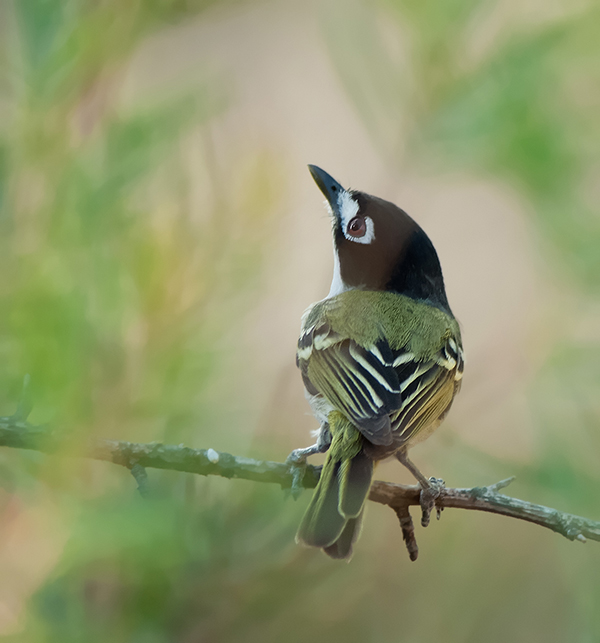
Tara: one of the most special birds of 2011, the endangered Black-capped Vireo (South Llano River State Park, TX). Being fast really paid off on this one
Which digiscopers and photographers really inspire you?
If it weren’t for the Digiscoper of the Year contest I would have no knowledge of most of the amazing digiscopers outside of the U.S. I had seen Isabel Ruiz’s work in last year’s contest, and just recently found her website. I really appreciate her technical expertise and her eye for a beautiful, well-composed photo. Spain has a LOT of great digiscopers. Kevin Bolton (U.S.) is a master at capturing feather detail. As for “regular” photographers, I have really enjoyed the work of Matthew Studebaker (U.S.).
What do you think will happen in digiscoping in the future?
I think it will become much more mainstream for serious birders trying to capture record shots, and especially for photographers wanting to take high quality wildlife photos. There are a lot more digiscoping-friendly camera choices now than just a few years ago. As the number of digiscopers increases, there will be more who will keep raising the bar on digiscoping flight shots. Digiscoping is certainly not the easiest way to capture birds in flight, but it is a natural way for a serious digiscoper to challenge him/herself to take the craft to the next level. I’d love to see a top-quality scope with an objective in the 95mm range—it would be heavy, but I’d be willing to carry it!

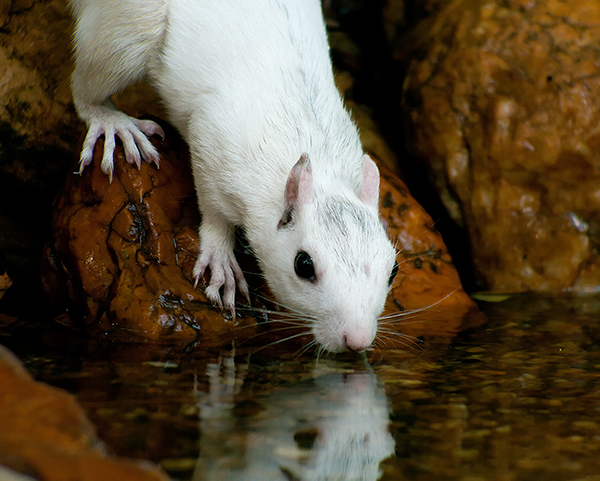
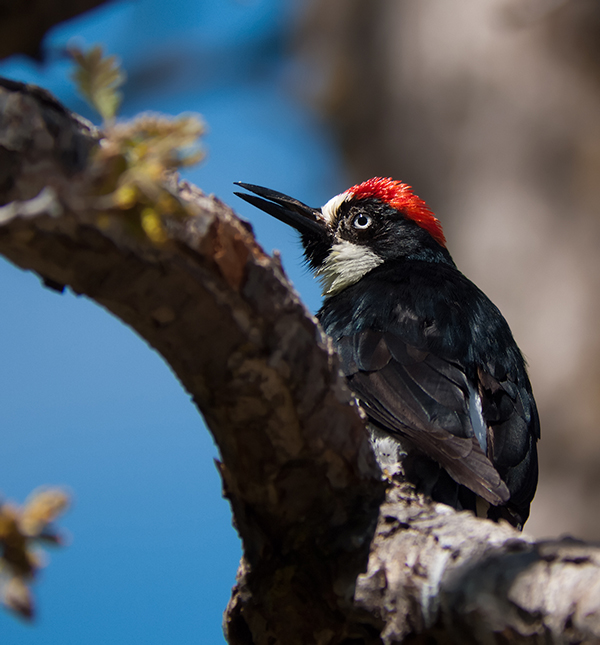
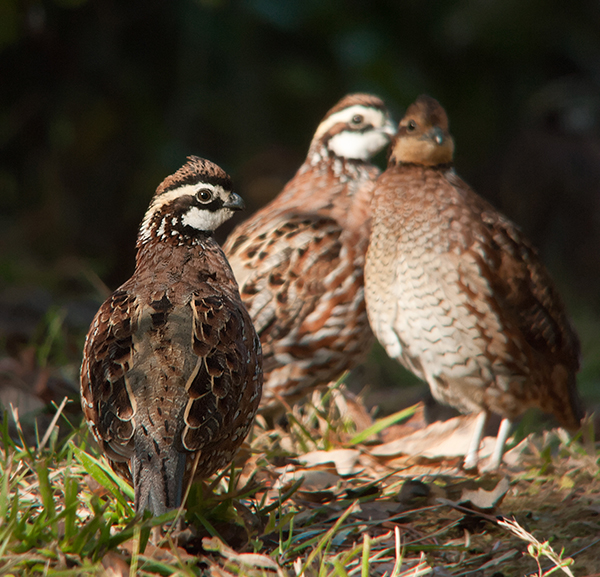
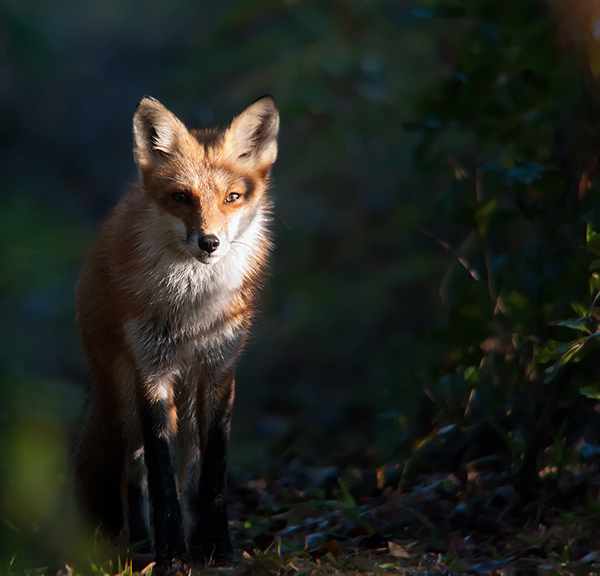
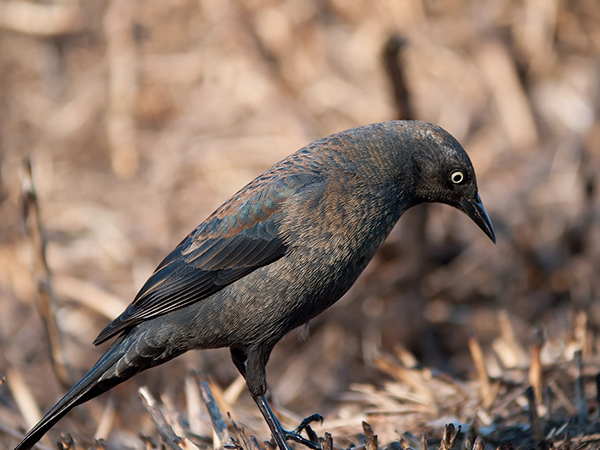
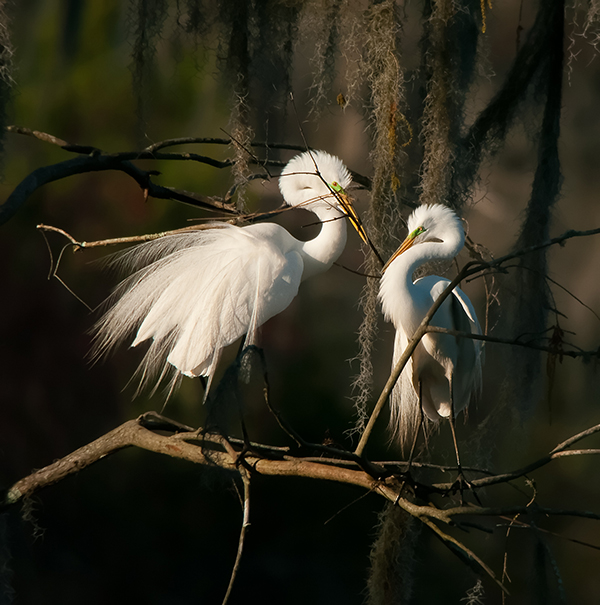
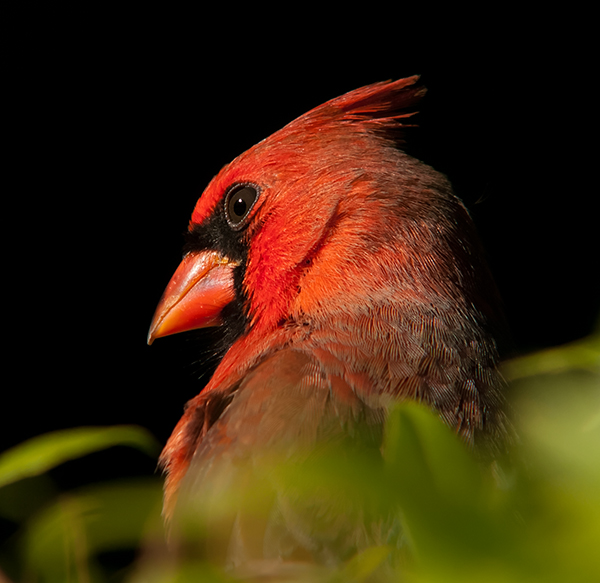
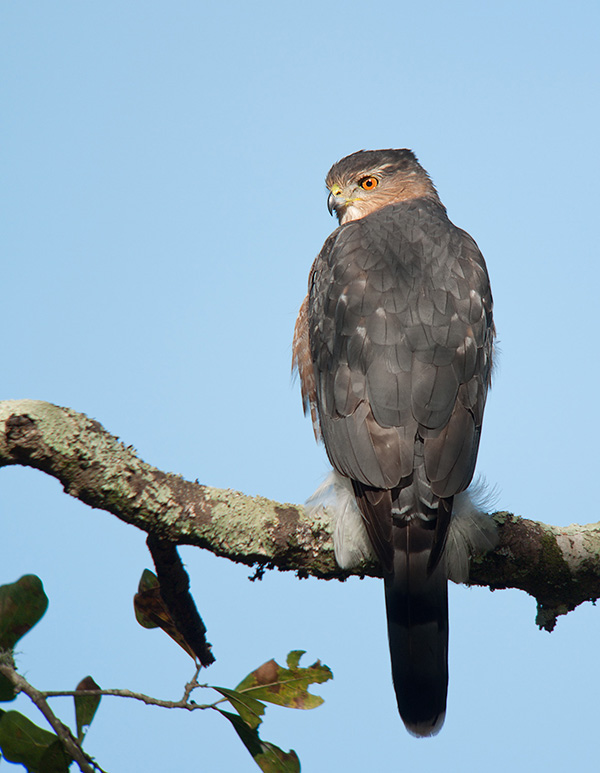
Congratulations on your achievement as Digiscoper of 2011… your images are great and as a fellow bird photographer, I admire your art…
Great post, Dale
Thank you Alex–I have enjoyed and admired your photos also!
Congratulations on a most deserving honor! Your photography is brilliant; thank you for sharing your birds with us…
Thank you Betsi–getting to share them is the best part.
Great interview and stunning pics!
Thank you Rebecca!
Stunning photos, congratulatios to a deserving winner.
Thank you so much Welsby!
Thank you so much Welsby!
Hi again Tara, do you have a website with more of your photos, would like to see more of your work,
Hi Welsby,
My photos are on Flickr: https://www.flickr.com/photos/focused-on-birds and my videos are on https://www.youtube.com/h2otara Some of the same videos are on Flickr, but the quality is much higher if you watch them on YouTube and select 720p.
Enjoy!
Tara
Es un placer compartir podio con Tara Tanaka, al igual que estar entre los mejores digiscopers del mundo.
Un saludo y enhorabuena.
Miguel Angel Muñoz
Gracias Miguel, es un placer compartir el podio con usted! Su foto Kestrel es realmente sorprendente.
Felicidades a ti también.
Fantastic Tara!! Just love your work to death. And thanks for the tips. Tom Berriman
Thanks Tom! I hope there was something useful in there!
Outstanding work Tara. You have many superb images that clearly demonstrate your excellent technique and skill.
Fernando B. Corrada
Outstanding work Tara. You have many superb images that clearly demonstrate your excellent technique and skill.
Fernando B. Corrada
Outstanding work Tara. You have many superb images that clearly demonstrate your excellent technique and skill.
Fernando B. Corrada
Thank you very much Fernando!
As if the winning photo wasn’t impressive enough. Those other shots are incredible! I would love to get shots like that, thanks for the tips!
You’re so welcome, and thank you!
Absolutely fantastic. These photographs have opened my ming to the possibility of considering individual birds – birds as individual creatures rather than as a species. Thank you. Tom Barr
Tom,
Thank you! I’m glad the photos could have such an effect!
Tara